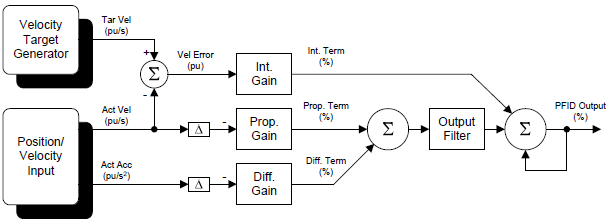
Velocity I-PD is an algorithm that can be used to perform closed-loop velocity control on a velocity axis. I-PD stands for the central gains used in this mode: Proportional, Integral, and Differential. The "-" indicates how the algorithm uses these gains.
For most velocity applications, the Velocity PID is more suitable than the Velocity I-PD. The Velocity I-PD does not respond as quickly and does not use Feed Forwards. Therefore, it will always lag behind the Target Velocity when it changes. It is easier to tune for no overshooting and can handle step jumps better than the velocity PID.
Velocity I-PD Advantages
Excellent for controlling an axis that follows an irregular signal, such as a reference signals that jumps, or a joystick.
Velocity I-PD Disadvantages
Lags behind the Target Velocity.
Motion Commands in Velocity I-PD Mode
The following commands are designed for use only with Velocity I-PD and automatically put the axis into the Velocity I-PD control mode during the commanded motion:
Move Velocity (I-PD) (38)
This command immediately sets the Target Velocity to the requested velocity. It does step-jump; it does not ramp it.
To use the Velocity I-PD control mode with other motion commands, use the Set Pos/Vel Ctrl Mode (68) command to set the Next Pos/Vel Control Mode to Vel I-PD. The next closed-loop motion command will use the control mode specified in the Next Pos/Vel Control Mode status register. The Current Control Mode register indicates the mode currently in use.
See the Closed Loop Control topic for details on which commands are supported in Velocity I-PD control.
Algorithm
Each closed loop motion command issued to the RMC specifies a target profile, which defines where the axis should be at any given moment. For each loop time when the axis is in closed loop control, the Velocity I-PD algorithm calculates the values from each gain, as described below. Then, the terms from the Proportional and Differential gains are subtracted from the Integral Gain term. The resulting value (in percent) is multiplied by the maximum output (typically 10V), to come up with the Control Output voltage for that loop time.
Gains and Feed Forwards
The Velocity I-PD uses the gains listed below. It does not use any Feed Forwards.
Integral Gain
The Integral Gain is multiplied by the accumulated Velocity Error.
Proportional Gain
In this control mode, the Proportional Gain multiplied by the change in the Actual Velocity is subtracted from the Control Output each control loop.
Differential Gain
In this control mode, the Differential Gain multiplied by the change in the Actual Acceleration is subtracted from the Control Output each control loop.
Higher-order gains may be used if Acceleration Control or Active Damping are selected. In addition, in Active Damping control, the Velocity I-PD does not use the Differential gain.
Tuning Velocity I-PD
The velocity I-PD gains must be tuned manually. The Tuning Wizard cannot be used to tune velocity I-PD control.
Diagram

See Also
Velocity Control | Velocity PID | Control Modes Overview
Copyright © 2025 Delta Computer Systems, Inc. dba Delta Motion